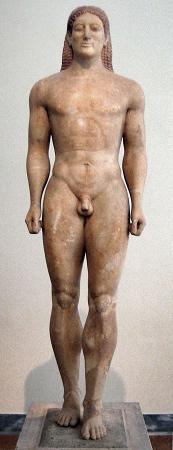
Kouros. A kouros is the modern term given to free-standing ancient Greek sculptures that first appear in the Archaic period in Greece and represent nude male youths.
In Ancient Greek kouros means youth, boy, especially of noble rank. Although Kouroi have been found in many ancient Greek territories, they were especially prominent in Attica and Boiotia.
The term kouros was first proposed for what were previously thought to be depictions of Apollo by V. I. Leonardos in 1895 in relation to the youth from Keratea, and adopted by Henri Lechat as a generic term for the standing male figure in 1904. Such statues are found across the Greek-speaking world; the preponderance of these were found in sanctuaries of Apollo with more than one hundred from the sanctuary of Apollo Ptoion, Boeotia, alone.
These free-standing sculptures were typically marble, but the form is also rendered in limestone, wood, bronze, ivory and terracotta. They are typically life-sized, though early colossal examples are up to 3 meters tall.
The female sculptural counterpart of the kouros is the kore. In Ancient Greek kouros means youth, boy, especially of noble rank. When a pubescent was received into the body of grown men, as a grown Kouros, he could enter the initiation fest of the brotherhood. Apellaios was the month of these rites, and Apollo was the megistos kouros. The kouros type appears to have served several func
In Ancient Greek kouros means youth, boy, especially of noble rank. Although Kouroi have been found in many ancient Greek territories, they were especially prominent in Attica and Boiotia.
The term kouros was first proposed for what were previously thought to be depictions of Apollo by V. I. Leonardos in 1895 in relation to the youth from Keratea, and adopted by Henri Lechat as a generic term for the standing male figure in 1904. Such statues are found across the Greek-speaking world; the preponderance of these were found in sanctuaries of Apollo with more than one hundred from the sanctuary of Apollo Ptoion, Boeotia, alone.
These free-standing sculptures were typically marble, but the form is also rendered in limestone, wood, bronze, ivory and terracotta. They are typically life-sized, though early colossal examples are up to 3 meters tall.
The female sculptural counterpart of the kouros is the kore. In Ancient Greek kouros means youth, boy, especially of noble rank. When a pubescent was received into the body of grown men, as a grown Kouros, he could enter the initiation fest of the brotherhood. Apellaios was the month of these rites, and Apollo was the megistos kouros. The kouros type appears to have served several func
Wikipedia ...